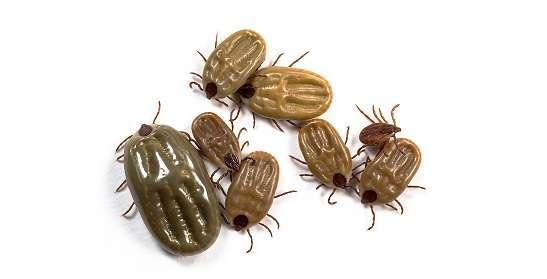Protect Your Pet Against Ticks

- posted: Apr. 15, 2023
Protect Your Pet Against Ticks
Warm days mean insects and ticks are active once again. Ticks are not only a nuisance to people but also to our pets and, they carry diseases. Let’s learn more about ticks and how to protect our pets from these parasites.
Ticks are arachnids like spiders and mites. There are multiple species, but the most common in the York area are the brown dog tick and the blacklegged tick (aka deer tick). Ticks live primarily in wooded areas in the tall grass but they do not actually live in or fall from trees. Ticks wait on the tip of a blade of grass and grab onto passing animals or people. Once on board, they find an area to bite and attach to the skin so they can feed on blood. Ticks may attach and feed for a period of several hours to several days after which time they detach and fall off in search of a new host.
Ticks carry a variety of diseases including Lyme disease, ehrlichiosis and anaplasmosis. Cats are less susceptible to these diseases but can be infected with Lyme, anaplasmosis and Cytauxzoonosis. These bacteria are carried by ticks and enter the bloodstream when the tick bites a pet or person. York County has a high incidence of Lyme disease with one in 15 dogs testing positive. All three diseases cause similar symptoms fever, lethargy, loss of appetite and stiff, sore joints. Ehrlichiosis and Anaplasmosis can also affect blood clotting, leading to bruising and bleeding. Some dogs can also develop severe kidney disease secondary to Lyme disease. Fortunately, most pets have few or no symptoms and, if they are symptomatic, most will recover if treated with antibiotics.
How can we protect our pets from ticks and the diseases they carry? Use a good quality flea and tick preventative regularly. Multiple safe topical and chewable options are now available for both cats and dogs and it pays to protect pets year-round not just during the spring and summer. Ticks do not die over the winter and can be active in temperatures as low as 35 degrees. Moreover, some ticks are actually more active during the fall—namely, the blacklegged tick that carries Lyme disease.
During high season or any time you are in tick territory, check your pets (and yourself!) daily and remove any ticks you find, especially after a walk in the woods or parks. No tick preventative is 100% effective, and, if there are enough ticks present, they will get on your pet. Try to avoid touching ticks with your bare fingers—use a tissue, gauze or tweezers to grasp the tick near its head and firmly pull it off. If the head did not come out, no worries: It will eventually fall off and it causes more damage and pain to try to dig it out.
Finally, consider vaccinating your dog against Lyme disease. There is no Lyme vaccine available for cats. Lyme vaccines are highly effective at blocking the transmission of disease if your dog is bitten by an infected tick. Dogs can get reinfected over and over from tick bites. You can almost eliminate the chance of your dog getting Lyme with this trifecta: vaccinating, using a good tick preventative year-round AND doing daily tick checks.
Talk to our vets about the best products to prevent ticks and whether your dog would benefit from the Lyme vaccine. Together, we can do a lot to protect pets against ticks and tick-borne diseases!
This blog brought to you by the Patton Veterinary Hospital serving Red Lion, York, and the surrounding communities.
Location
Patton Veterinary Hospital
425 E Broadway
Red Lion, PA 17356
